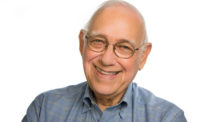Interview with James Stewart Polshek, FAIA
RECORD speaks to the 2018 AIA Gold Medal award winner.

Photo © Aislinn Weidele
Architects & Firms
“I thought it was a robocall,” James Polshek says about answering the phone to news that he’d won the 2018 American Institute of Architects (AIA) Gold Medal. “It was a chilly day, and I was walking up 6th Avenue after leaving a chronologically required hearing test, when the phone rang.” Polshek is 87, but could hear the news just fine: “At that point, I kind of lost my breath,” he says. “I was laughing and sobbing simultaneously, with enjoyment, pleasure, and some disbelief.”
A 1955 M.Arch. graduate of Yale University, Polshek founded his eponymous firm in 1963, which evolved through the years to become Ennead Architects in 2010, five years after his retirement. He spoke with RECORD by phone after learning about the AIA award.
Architectural Record: Which projects are you proudest of, and why?
You know the saying, “If you have many children . . .” The most obvious one is perhaps the most nationally prestigious: the Clinton Library. But my two favorites came in succession in 1969 and 1972 and gave me the confidence to pursue the way I wanted to practice. The first was the New York State Bar Association in Albany, which won the 1972 AIA Honor Award for merging a historic building in a historic district with a modernist interpretation. The second is called the Five County Consulting Center in Columbus, Indiana, which solved environmental and ecological problems, as the building is a bridge over a creek that flooded severely. We used some of the foundation budget to stop the Army Corps of Engineers from simply widening the creek. Those two together—and the various themes that connect to later projects—were seminal.
As a past dean of Columbia University’s Graduate School of Architecture, Planning and Preservation, what would you say about the core values young architects should learn and how they can prepare for the profession?
I encourage younger people to study architecture if they feel it in their bones, but not to be deluded early on by an excessively romantic notion that design is the be-all and end-all; there are many ways to practice architecture. Architecture inherently is an intellectual discipline, but it’s also a boot camp.
My first job was in I.M. Pei’s office when it was very small, 12 people or so, and it was embedded within the office of real-estate developer William Zeckendorf. There was such an ethos of excellence in the air. Everything was done with such loving care, and there was a great deal of mutual respect. I was low man on the totem pole, designing elevator cores, nothing terribly romantic.
I learned a lot there, and I transferred a lot of what I learned to my own firm. I also recognized talent: people were hired and mostly never left. Encouragement became contagious. There were attitudes I expressed that began to inform a specific, collaborative practice.
How did the firm evolve?
It changed from a single name three or four times, each time becoming more distant from a single-person-led practice. Its growth was beginning to make me nervous. It’s one thing when you have a practice of 30, 40, even 50 or 60 people, but when it gets to be double that, the chemistry changes. So I decided to step back slowly, starting in ’05, Five years later, I made a clean break, and they renamed it. A name is far less important than quality of work, and that’s remained very high.
What kinds of moral or ethical codes become embedded in your work?
From the beginning, I steered away from projects that didn’t make a specific, verifiable contribution to the common good of the place in which they were to be. You can’t lose sight of who’ll ultimately be affected by what you do. I have colleagues and friends who’d argue with me that architecture is an apolitical pursuit. There is this inborn professional schizophrenia: whether it’s possible to rationalize buildings as purely built form or as political contributors to the context in which they exist. But architecture is neither one nor the other. That’s nonsense—not even neurosurgery is apolitical. Most people who came to the office came to agree and felt stimulated by the environment we worked in. I hope that’s a legacy I’ll leave behind.



